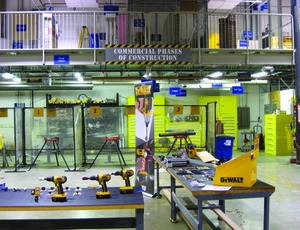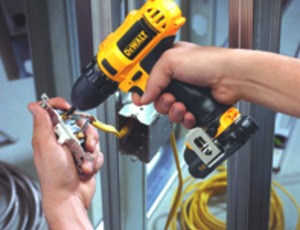Earlier this month at Stanley Black and Decker University in Towson, Md., DeWalt unveiled its new 20V Max line of cordless power tools. Building upon the success of last year's 12V Max line, the tools represent a break from the brand's 15-year-old cordless 18-volt lineup and provide a glimpse into Stanley Black and Decker's plans for the many brands in its stable.


The initial launch for the 20V Max line will include a hammer drill, a drill-driver, two impact drivers, a rotary hammer, a circular saw, a reciprocating saw and an LED work light. While the tools will not be available until September, the introduction of a new battery system that is incompatible with the existing 18V line should generate some buzz.
The 20V Max battery is technically still an 18-volt battery, comprising five 3.6-volt lithium-ion cells. The crucial difference is in its slide-on design, which is not compatible with the stem-style batteries used with DeWalt 18V cordless tools since their introduction in 1996.
The slide-on battery is similar to the battery used in the DeWalt 12V Max compact-tool line introduced last year, and both can be charged from a single charger. The 20V Max batteries come in 1.5- and 3-amp-hour versions, so a lighter battery can be used when extensive run times are not needed. Prices currently are estimated at $69 to $79 for the 1.5 amp-hour and $99 for the 3.0 amp-hour. But the cost may seem high to a user already invested in the DeWalt 18V system.
“We called it 20V to reduce confusion among users. They can see the difference in the battery's performance,” says Chris Keffer, cordless-tool product manager for DeWalt. “The 18V system will stay in our line until the users tell us they don't want to use it.” A combination charger for the 18V and the 12V and 20V Max batteries will be available later this year to ease the transition, according to DeWalt.
The new line allowed DeWalt engineers to update their designs. As with the 12V Max tools, moving the battery into the base allows for a thinner, more ergonomic grip. There were also many tool-specific tweaks. “The drills have been redesigned from the ground up,” says Joerg Zellerhoff, De-Walt cordless senior project manager. “They are much more compact and now have multiple LEDs to eliminate shadows.”
Since the Stanley and Black and Decker merger last year, brand definition has been an issue. According to DeWalt representatives, Black and Decker will remain a consumer brand, while Bostich will target hobbyists and do-it-yourselfers. Porter Cable will tackle high-power heavy construction and industrial applications, while DeWalt will fill the considerable field of residential and commercial construction.
Still, there is the persistent risk of alienating customers with new standards in what remains a weak construction market. After first noting the company's recent positive sales performance in its lower-cost, battery-less bare tool program, DeWalt's Keffer takes the long view. “Our company has decided that cordless is the way to go. In the last three years we doubled the engineering resource in cordless, and the result is the 12V Max and 20V Max systems. Right now we're looking to make every application cordless.”




Post a comment to this article
Report Abusive Comment